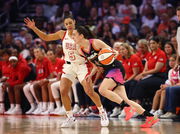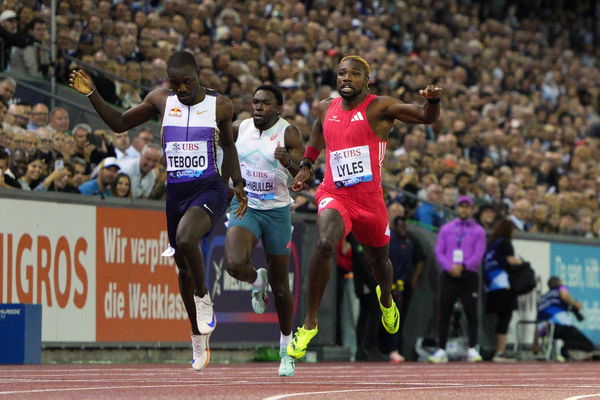
Imago
2023 World Athletics Championships Budapest Towa Uzawa JAP, Courtney Lindsey USA, Tamil Guliyev TUR, Mens 200m Qualification Heat Five, during the 2023 World Athletics Championships at National Athletics Centre, Budapest, Hungary on 23 August 2023.. Editorial use only , Copyright: xIanxStephenx PSI-17887-0412

Imago
2023 World Athletics Championships Budapest Towa Uzawa JAP, Courtney Lindsey USA, Tamil Guliyev TUR, Mens 200m Qualification Heat Five, during the 2023 World Athletics Championships at National Athletics Centre, Budapest, Hungary on 23 August 2023.. Editorial use only , Copyright: xIanxStephenx PSI-17887-0412
Some big records are on the line as the 2025 World Athletics Championships become the focus for the next 9 days. Noah Lyles is going for his fourth World Championships gold in the 200m sprint. Ethiopia’s Tigist Assefa will be relishing her marathon duel with Kenya’s Peres Jepchirchir as the former aims to claim the gold she missed out on in the Paris Olympics.
Watch What’s Trending Now!
It’s gearing up to be another exciting World Championships. But how have the athletes been selected for this biennial event? There are numerous systems in place to ensure its competitiveness, while showcasing the best athletes of the season. So, let’s take a look at the qualification standards that decided selection for the 2025 Tokyo World Athletics Championships.
ADVERTISEMENT
How do athletes qualify for the World Athletics Championships 2025?
With more than 50 events that will take place in the Tokyo Championships, each of the events has the same pattern of qualification. A certain percentage (on average, roughly 50%) of the competitors are seen to qualify by clearing the event entry standards. And the rest qualify through their standings in the World Rankings, or via the Wild Card criteria, like being the current World Champion or winning the Challenger tournaments.
Mind you, the qualification windows are not the same for every event. The marathon and the 35km race walk had their consideration period from November 5, 2023, to May 4, 2025, the earliest of all the events. The 10,000m, 20km race walk, combined events, and relays had the window from February 25, 2024, to August 24, 2025. For all the remaining events, the period was August 1, 2024, to August 24, 2025.
Top Stories
Cam Newton Makes NFL Return Conditions Clear to 32 Teams as Panthers Legend Confirms Retirement Stance

Caitlin Clark Shows Concerning Signs vs. Kelsey Plum During USA Camp Debut, per National Reporter

Tom Brady Makes Career Announcement for Vegas as Pete Carroll Addresses Losing Raiders Locker Room

“RIP”: Prayers Pour In as Tom Brady’s Raiders Struck by Tragedy

“NFL Was Crying”: Maxx Crosby Says League Forced Him to Remove Shoes Honoring His Daughter

“Rest in Peace”: Prayers Pour In From Dan Marino as Dolphins Legend Mourns Tragedy in South Florida Football

Now, let’s take a look at the entry standards for the Tokyo Championships events.
ADVERTISEMENT
What are the entry standards for each event at the Tokyo World Athletics 2025?
Here are the entry standards listed for each event. We start with the men’s division first.
ADVERTISEMENT
100m – 10.00 seconds
200m – 20.16 seconds
400m – 44.85 seconds
ADVERTISEMENT
800m – 1:44.50 minutes
1500m (Mile / Road Mile standard) – 3:33.00 minutes (3:50.00)
5000m / 5km road – 13:01.00 minutes
ADVERTISEMENT
10,000m / 10km road – 27:00.00 minutes
Marathon – 2:06:30 hours
3000m Steeplechase – 8:15.00 minutes
ADVERTISEMENT
110m Hurdles – 13.27 seconds
400m Hurdles – 48.50 seconds
High Jump – 2.33m
ADVERTISEMENT
Pole Vault – 5.82m
Long Jump – 8.27m
Triple Jump – 17.22m
ADVERTISEMENT
Shot Put – 21.50m
Discus Throw – 67.50m
Hammer Throw – 78.20m
Javelin Throw – 85.50m
Decathlon – 8550 points
20K Race Walk – 1:19:20 hours
35K Race Walk – 2:28:00 hours

Imago
Athletics: Diamond League final Noah Lyles R of the United States wins the men s 200-meter event ahead of Letsile Tebogo L of Botswana at the Diamond League athletics final in Zurich on Aug. 28, 2025. PUBLICATIONxINxAUTxBELxBIHxBULxCZExDENxESTxFINxFRAxGEOxGERxGRExHUNxISLxIRLxITAxLATxLTUxLUXxLIExMKDxNORxPORxPOLxROUxSVKxSUIxSRBxSLOxESPxTURxUKxUAExONLY A14AA0004795524P
Now, for the women’s events:
100m – 11.07 seconds
200m – 22.57 seconds
400m – 50.75 seconds
800m – 1:59.00 minutes
1500m (Mile) – 4:01.50 minutes (4:19.90)
5000m / 5km Road – 14:50.00 minutes
10,000m / 10km Road – 30:20.00 minutes
Marathon – 2:23:30 hours
3000m Steeplechase – 9:18.00 minutes
100m Hurdles – 12.73 seconds
400m Hurdles – 54.65 seconds
High Jump – 1.97m
Pole Vault – 4.73m
Long Jump – 6.86m
Triple Jump – 14.55m
Shot Put – 18.80m
Discus Throw – 64.50m
Hammer Throw – 74.00m
Javelin Throw – 64.00m
Heptathlon – 6500 points
20k Race Walk – 1:29:00 hours
35k Race Walk – 2:48:00 hours
See something missing? Yes, the relay events. For that, be it the men’s, women’s, or the mixed relays, the selection criteria are the same: Top 14 at the 2024 World Relays held in Nassau, Bahamas + 2 from the World List based on performance who have still not been selected.
And now comes the rule of all rules, without which everything that the athletes do, the sacrifices, the hours of hard work, becomes meaningless.
Understanding the anti-doping rules and testing procedures
The World Athletics, the organizing body of the Japan World Championships, is a signatory to the World Anti-Doping Code (“Code”). The Anti-Doping Rules (ADR) codified have been adopted by the World Athletics Council, and the regulations will be implemented as per the updated 2021 version of the Code.
These Anti-Doping Rules formulated by WADA must be interpreted as independent and not limited by the standing law or regulations of any signatory athletics federation or government. We can go on and on, as it is an intricate framework that has been prepared with the utmost detail and no room for loopholes.
The onus is on the athletes as the provisions of the Anti-Doping Rules clearly mention:
Athletes must:
(a) be knowledgeable of and comply with these Anti-Doping Rules at all times;
(b) know what constitutes an anti-doping rule violation and the substances and methods that have been included on the Prohibited List;
(c) be available for Sample collection at all times;
(d) take responsibility, in the context of anti-doping, for what they ingest and use;
(e) carry out research regarding any products or substances that they intend to use (prior to such Use) to ensure that using them will not constitute or result in an anti-doping rule violation. Such research must, at a minimum, include a reasonable internet search of:
(i) the name of the product or substance;
(ii) the ingredients/substances listed on the product or substance label;
(iii) other related information revealed through research of points (i) and (ii).
The testing procedures similarly put the onus on the athlete to be available for testing, keeping the testing authorities informed about one’s whereabouts so that the whole procedure can be completed without much difficulty for the testing team. We recommend you go through the details in order to get a comprehensive idea about the whole subject of anti-doping enforcement.
How does the world rankings system influence qualification?
The first and foremost criterion for selection is the entry standards. But the ones who do not meet the criteria still have a way to make it to the Championships, like 7 athletes from Belgium for the Japan World Athletics Championships. And they owe it to their World rankings.
Rani Rosius (100m), Imke Vervaet (200m), Ilona Masson (triple jump), John Heymans (5,000m), Elie Bacari (110m hurdles), Jente Hauttekeete (decathlon), and Thomas Carmoy (high jump) were placed among the top 36 in the world, who made it despite not clearing the entry standards.
But does that mean the new formula of the World Athletics Council discourages quality? On the contrary, the season rankings are obviously based on their past year’s performances, making it still a competitive selection and maintaining the quality of the events.
What are the key rules athletes and federations must follow?
There are many rules that still filter the selection. The most basic of them is age. Doesn’t matter how talented you are; you can only travel to Japan if you are at least 16 years old (the cut-off date being 31 Dec 2025). Not applicable for the current Worlds, but when there’s a U18 or U20 tournament, the cut-off is December 31 of the year of the tournament.
Ok, so there is also the Wild Card provision: Defending world champions (2023) and 2025 Diamond League winners earn automatic entry. The wildcard entries are generally not counted in the nation’s quota, and there’s always discretion that the Federation can resort to. But only until the fulfillment of the quota. Federations determine final athlete selection; entering athletes beyond those qualified is not permitted.
ADVERTISEMENT
ADVERTISEMENT
ADVERTISEMENT

